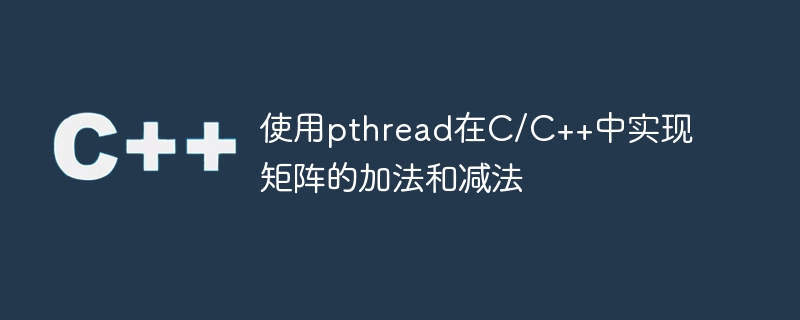Heim >Backend-Entwicklung >C++ >Verwenden Sie pthread, um Matrixaddition und -subtraktion in C/C++ zu implementieren
Verwenden Sie pthread, um Matrixaddition und -subtraktion in C/C++ zu implementieren
- WBOYWBOYWBOYWBOYWBOYWBOYWBOYWBOYWBOYWBOYWBOYWBOYWBnach vorne
- 2023-08-28 09:05:071259Durchsuche

Hier erfahren Sie, wie Sie eine Matrixaddition und -subtraktion in einer Multithread-Umgebung durchführen. pthread wird verwendet, um mehrere Threads gleichzeitig in C oder C++ auszuführen.
Es gibt zwei Matrizen A und B. Die Reihenfolge jeder Matrix ist (m x n). Jeder Thread erhält jede Zeile und führt eine Addition oder Subtraktion durch. Daher gibt es für m Zeilen m verschiedene Threads.
Beispiel
#include<iostream>
#include <pthread.h>
#include <cstdlib>
#include <cstdint>
#define CORE 3
#define MAX 3
using namespace std;
int AMat[MAX][MAX] = {{10, 20, 30},
{40, 50, 60},
{70, 80, 50}
};
int BMat[MAX][MAX] = {{80, 60, 20},
{30, 20, 15},
{10, 14, 35}
};
pthread_t thread[CORE * 2];
int add[MAX][MAX], sub[MAX][MAX];
void* addMatrices(void* arg) {
intptr_t core = (intptr_t)arg;
// Each thread computes 1/3rd of matrix addition
for (int i = core * MAX / 3; i < (core + 1) * MAX / 3; i++) {
for (int j = 0; j < MAX; j++) {
add[i][j] = AMat[i][j] + BMat[i][j];
}
}
}
void* subtraction(void* arg) {
intptr_t core = (intptr_t)arg;
// Each thread computes 1/3rd of matrix subtraction
for (int i = core * MAX / 3; i < (core + 1) * MAX / 3; i++) {
for (int j = 0; j < MAX; j++) {
sub[i][j] = AMat[i][j] - BMat[i][j];
}
}
}
void display(){
cout << "Matrix A: " << endl;
for(int i = 0; i < MAX; i++) {
for(int j = 0; j < MAX; j++) {
cout << AMat[i][j] << " ";
}
cout << endl;
}
cout << "\nMatrix B: " << endl;
for(int i = 0; i < MAX; i++) {
for(int j = 0; j < MAX; j++) {
cout << BMat[i][j] << " ";
}
cout << endl;
}
}
void displayRes(){
cout << "\nAddition: " << endl;
for(int i = 0; i < MAX; i++) {
for(int j = 0; j < MAX; j++) {
cout << add[i][j] << " ";
}
cout << endl;
}
cout << "\nSubtraction: " << endl;
for(int i = 0; i < MAX; i++) {
for(int j = 0; j < MAX; j++) {
cout << sub[i][j] << " ";
}
cout << endl;
}
}
main() {
display();
int step = 0;
for (int i = 0; i < CORE; i++) {
pthread_create(&thread[i], NULL, &addMatrices, (void*)step);
pthread_create(&thread[i + CORE], NULL, &subtraction, (void*)step);
step++;
}
for (int i = 0; i < CORE * 2; i++) {
pthread_join(thread[i], NULL);
}
displayRes();
}Ausgabe
Matrix A: 10 20 30 40 50 60 70 80 50 Matrix B: 80 60 20 30 20 15 10 14 35 Addition: 90 80 50 70 70 75 80 94 85 Subtraction: -70 -40 10 10 30 45 60 66 15
Das obige ist der detaillierte Inhalt vonVerwenden Sie pthread, um Matrixaddition und -subtraktion in C/C++ zu implementieren. Für weitere Informationen folgen Sie bitte anderen verwandten Artikeln auf der PHP chinesischen Website!

